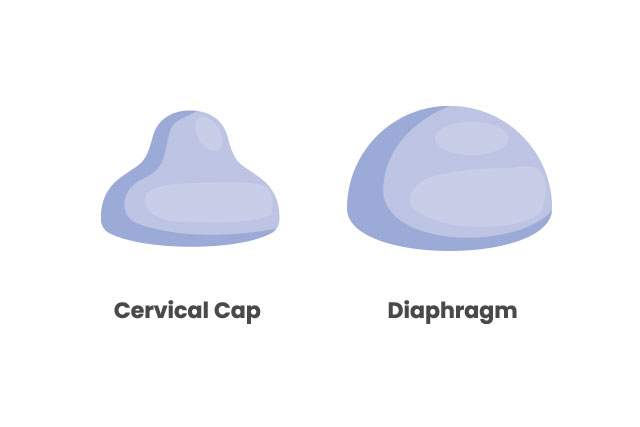Cervical caps have been used since the beginning of the 19th century. Due to their simplicity and convenience, these birth controls are still widely used in the US and Europe. Of course, their popularity rates are far from those of mini pills and condoms, but they are still available as non-hormonal, barrier contraception.
The quality of any contraception is always determined by how effective it is. A cervical cap has a 71% to 86% efficacy rate. This depends on whether a woman uses it with spermicide cream and whether she has a baby. Cervical caps tend to work better in those who have never delivered a baby.
This device belongs to barrier contraceptives as its mechanism of action implies the creation of an obstacle for the sperm to be unable to get to the uterus.
How Do Cervical Caps Work?
The mechanism of work of a cervical cap is super simple. The cap is placed high in the vagina to close the opening connecting the cervix with the uterus. This way, the device prevents the sperm from getting to the places in the female reproductive system where it can fertilize the egg.
Due to the vacuum that is created, the cervical cap stays in place throughout sexual intercourse. Yet to make a vacuum possible, it’s essential to pick the size of the cervical cap that will fit you perfectly. Your OB can help you with that. It shouldn’t be too big not to cause pain or discomfort. Neither should it be too small, as this will level its protective properties.
Cervical Caps vs. Diaphragms
Due to a range of similarities in their appearance and function, people often compare the cervical cap vs. the diaphragm. Both are dome-shaped and both are barrier contraceptives. Both are intended for women, yet there is a range of aspects that make them different things.
A cervical cap is smaller and covers the cervix only, while the diaphragm is bigger and protects the cervix and the surrounding area. Diaphragms are significantly more effective than cervical caps. Their effectiveness rates reach 92 – 96%.
There is also a significant difference in how long you can keep them inside the vagina. The diaphragm is safe for 24 hours. While the cervical cap – 48 hours. At the same time, the former remains effective for preventing pregnancy for 6 hours, whereas the cervical cap keeps you safe for 48 hours.
How Do I Use a Cervical Cap?
Before using a cervical cap, you should make an appointment with your healthcare provider to help you pick the size of the cap that will fit you. At your appointment, your doctor will also give instructions on how to use a cervical cap.
The cervical cap should be installed before each time you are going to have sex. Follow these steps to make it work:
- Wash your hands before taking the cap from the container.
- Put spermicide cream on the inside and the outside of the cervical cap, distributing it with a thin layer.
- If you use tampons, take the same pose you use to insert them with the cervical cap.
- Open the vulva with the fingers of one hand and start to put the cap inside gently. Squeeze the rim of the cap for it to fit better.
- Push it as deep as your finger can reach and make sure it has taken the right position in the cervix. Otherwise, it won’t protect you from pregnancy.
How Long Does the Cervical Cap Last?
You can use the same cervical cap for up to two years, so it is a very cost-effective birth control method. To maintain its integrity and therefore effectiveness, you should care for the device properly and regularly check it for any signs of wearing off.
Do not boil or sterilize it in any other way. Just wash it with warm soapy water and let it air dry.
Removing a Cervical Cap
Here’s what you should do to remove the cervical cap:
- Squat down and insert two fingers into the vagina to find the cap.
- Push against the dome. This will break the suction allowing you to remove the device safely.
- Hold the cap by the strap and start pulling it out gently.
Benefits and Risks
Depending on what you seek, the benefits of the cervical cap are:
- no hormones used;
- it’s convenient to use;
- it doesn’t require any withdrawal to get pregnant; you just don’t insert it if you want to start attempting a baby;
- neither you nor your partner feels any discomfort during the use;
- you don’t need to interrupt sex to use the cap as it is in the case with condoms;
- they can be used for a long time and are therefore cost-effective.
As for the risks, they include:
- increased risk of infection;
- the risk of toxic shock syndrome;
- 15 – 30% chance of method failure;
- caps require some skill to be inserted correctly;
- you have to visit a doctor to pick the right cap size.
Summary
A cervical cap is a good option for people who want to avoid using hormonal contraception but don’t want to feel discomfort with using condoms. If following all the recommendations and using it with a spermicide cream, the cervical cap contraceptive properties are quite high.
FAQ
Is a Cervical Cap Painful?
No, it is not. If you feel any pain or discomfort, you’ve probably chosen the wrong size of cap.
Who Can Use a Diaphragm or Cap?
These methods are safe for healthy individuals with no current gynecological conditions. They shouldn’t be used by women allergic to silicone or spermicide and during menses.
How Long Can a Cervical Cap Provide Protection even Without Additional Spermicide?
This contraceptive remains effective for up to 48 hours.




